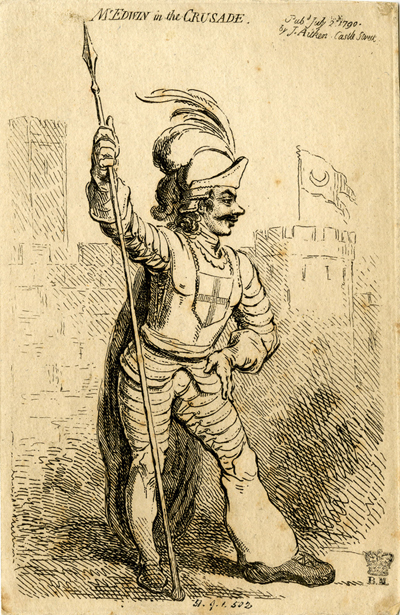Mr Edwin in The Crusade
\As they do today, popular actors and actresses in the 18th century had a certain fascination for the general public. Even if they were not as well-known as, say, David Garrick, John Philip Kemble, Sarah Siddons, or Dorothea Jordan, they were often portrayed in numerous prints as themselves or, even more frequently, in the roles they had made popular.
So in the case of the relatively obscure (to us) comedian John Edwin (1749-1790), there are more than a half dozen prints in the British Museum showing him as various characters—as Croaker in Oliver Goldsmith's The Good Natured Man (1788), as Autolycus in Shakespeare's The Winter's Tale (1785) as Tom Thumb in Henry Fielding's play of the same name (1780), as Lingo in O'Keefe's The Agreeable Surprise (1784), and as other comic characters in plays, operettas, and farces that are less well known.

© Trustees of the British Museum
In this print, he appears as Sir Troubadour standing before the walls of Jerusalem in Frederick Reynolds' The Crusade, a grand historical romance/opera in three acts, first performed on May 6, 1790 at the Theatre-Royal, Covent-Garden.
As described by the London Times, May 07, 1790,Pg. 4, Sir Troubadour is "a KNIGHT ERRANT fighting not only against the Saracens, but the GOUT," so the flannel on his leg is part of his character. Much of the opera consists of his quest, along with the commanders Raymond and Godfrey, to free the Christian heroine, Constantia, (played by Mrs. Billington) who had been captured by the Saracens in the first act.
Quoting from the Life and Times of Frederick Reynolds, the British Museum commentary on this print mentions an unfortunate incident which is supposed to have occured on the opening night of the run.
On the first night, 6 May 1790, of this opera or historical romance by Reynolds, 'Edwin, who in the second act was to have assumed the disguise of a young Tartar prince,... to make love to the heroine, Constantia, being unable from sudden, and great illness, to change his dress, actually wooed the beautiful Mrs. Billington in tattered armour and flannel.
But, as written, this is probably mistaken. In its review of the opening night performance, the Friday May 7th edition of The Public Advertiser states that Sir Troubadour and Raymond first gain entry to the fortress where Constantia is being held "disguised as a priest and a woman." So before the scene with Constantia, Edwin would have been attired as a woman, NOT in armor and flannel. And then, according to the same review
5ir Troubadour, disguised as the woman, by accident gets into the tent where the Prince, is sleeping—puts on his cloaths, and passing for the Prince, takes away Constantia from prison.
There is no mention in The Public Advertiser of a "sudden, and great illness" nor of a problem with getting into the Prince's clothes. Nor is there any mention of a wardrobe malfunction in the first night reviews by either the London World or the London Times, which was very free with advice about other aspects of the performance. This is not to say that such an incident never occurred, but that it is unlikely to have occured on opening night, nor in the precise way described in the Frederick Reynolds memoir.
Like many of his associates, Edwin was a highly entertaining companion, but a hard drinker, and, according to the Dictionary of National Biography, "used to reach the theatre drunk at the bottom of a chaise. The clothes were thrust upon him and he was pushed on to the stage when he was able to collect himself, and 'his acting seemed only the richer for the bestial indulgence that had overwhelmed him.'" Given such habits, a sudden fit of retching would not have been extraordinary on one of the many nights of the first run. Whether his drinking had anything to do with it, Edwin was not part of the revival of The Crusade in October of 1790, and he died on October 31 at the age of 41.
Sources and Reading
- Commentary from the British Museum on Mr Edwin in the Crusade.
- "John Edwin, the Elder," Dictionary of National Biography
Comments & Corrections
NOTE: Comments and/or corrections are always appreciated. To make that easier, I have included a form below that you can use. I promise never to share any of the info provided without your express permission.